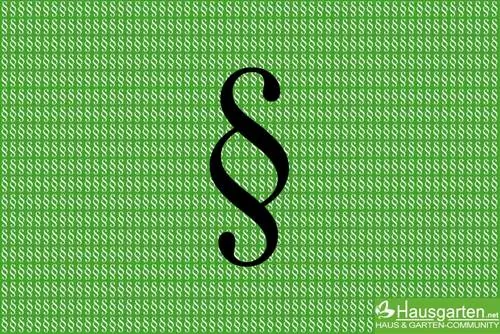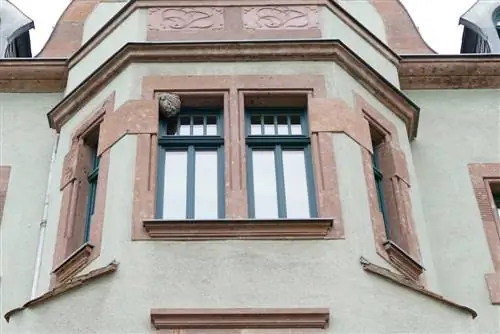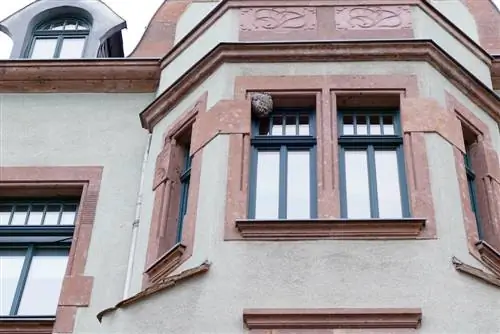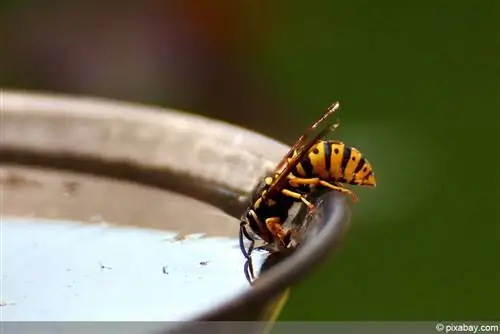- Author admin [email protected].
- Public 2023-12-17 03:39.
- Last modified 2025-01-24 12:45.
An abandoned wasp nest in the attic, hidden in the roller shutter box or in the garden soil causes headaches. Now there are important questions about how to properly deal with the old nest. Should old wasp nests be removed in winter? Does the decomposition process damage the roof structure or roller shutter box? Is there a risk that the queen wasp or her workers are still inside? When do wasps actually die? Read well-founded answers to all questions about the best way to deal with old wasp nests here.
Remove old wasp nests in the house or not?
It is your individual decision whether you leave an old wasp nest in the house at its location or remove it. Unless the structure is disruptive, it will resolve itself over time. This process does not cause any damage to the structure to which the nest is attached. We have summarized the most important arguments for both alternatives below:
Hanging
- The occupied building site prevents a colony of wasps from settling here again
- In a cavity, the old nest replaces the insulation removed by the insects for construction
- In a difficult-to-reach location, no dangerous maneuvers are required to reach the nest
Eliminate
- Old wasp nests in a roller shutter box can block the barrel
- On a Roto roof window, the nest prevents unhindered opening and closing
- The abandoned building hangs on a gutter and accumulates the rainwater runoff
There is no reason to remove an old nest because you fear re-infestation by wasps. Although scientists are still puzzling over many questions about the behavior of a queen wasp, one thing is certain: she never takes over an existing nest.
Tips for removing nests
If a roller shutter is unusable or if old wasp nests are otherwise disturbing, you cannot avoid removing it. In order to be able to use the occupied roller shutter box again, open the casing. You can break out the rough parts of the structure by hand. A vacuum cleaner is used to remove any remaining residue that has become stuck in the grooves and cracks. Finally, make the roller shutter work again.
If the abandoned wasp nest is at a dizzying height, such as under an eaves where it is blocking a gutter, the roofer or carpenter will be happy to help you. These professionals are not only afraid of heights, but also have sturdy ladders and tools to get the offending structure out of the way.
Tip:
Have you decided to remove an abandoned wasp nest? Then from an ecological point of view it makes a lot of sense to consider a date in spring. Until March/April, numerous beneficial insects, such as lacewings, prefer to overwinter in old wasp nests.
Disposal on the compost heap

An old wasp nest is pure organic waste. It consists mainly of wood fibers, which the wasps process into a paper-like shell. To do this, the insects fly to the wood supplies in the area. Here a wasp is targeting so-called grayed wood, which is found on the weathered surface of slats, planks and boards. It contains no lignin, only cellulose. By swinging its head and walking backwards at the same time, the wasp scrapes off the wood fibers with its upper jaw. She uses her saliva to process the cellulose into clumps, which she installs along an unfinished edge of the nest. Over time, the round structure is created with internal honeycombs and double outer layers for thermal insulation. The entire nest is made of natural materials that you can dispose of in the compost.
Is an empty wasp nest really empty?
Between November and April you can assume that a wasp nest is actually abandoned. Up to this point, the old wasp queen has taken care of enough offspring, lovingly cared for by the workers. The young queens hatch in late summer and are mated by the males. The Old Queen and her entire people then die in the fall. The young queens now leave their native nest and look for safe winter quarters in barns, cracks in walls or rotten trees. In March, the spring sun wakes up the young wasp queens, whereupon they start looking for a suitable location to found their own wasp colony.
Tip:
If wasps suddenly fly out of a seemingly abandoned nest, keep calm. Don't hit the insects or flail your arms in panic. Such reactions make the animals angry and aggressive. Instead, please move away from the nest with calm, quick movements.
Remove earth wasp nests better
A variety of wasp species are not afraid to create a nest in the ground. If the building is abandoned, you will hardly be able to understand afterwards whether the inhabitants were actually wasps. It is entirely possible that bees or hornets acted as builders here. In this case, it cannot be ruled out that the building will be occupied again next year and significantly expanded. In addition, every earth nest represents a permanent danger as a tripping hazard. How to remove an old earth nest professionally:
- A mild day between November and March is suitable
- The ground is not frozen
- Dig up the earth with the spade to dig out all the passages
After the earth nest is destroyed, the remaining scents can still attract a new colony of wasps next year. By covering the scents with natural products, the insects no longer perceive the location as a possible nesting place. If possible, grow garlic, basil or tomatoes here because wasps detest these smells. Ethereal scents also put off an interested young queen. If you stick cloths soaked with ammonia into the ground, any wasps that fly in will run away straight away.
Inhabited wasp nests must not simply be destroyed

Old wasp nests can be removed without any concerns. However, as long as a building is still inhabited, it is subject to nature conservation. This includes all colony-forming insects, such as wasps, bees, hornets and bumblebees. The strict legislation only allows an exception for the common wasp and the German wasp if their presence poses a danger to life and limb. The Federal Nature Conservation Act even stipulates in paragraph 39, paragraph 14 that the development of insects must not be disturbed. Violations are punished with a fine of up to 50,000 euros. The action against a wasp nest must therefore be carefully considered. If you see a danger for your small children, allergy sufferers or seniors living in the house with limited mobility, written approval is required. For this purpose, please contact the city administration, the BUND or a qualified exterminator. Only after an expert has confirmed the dangerous situation in advance can you lend a hand to inhabited nests of wasps or other insects.
The removal of an active wasp nest certainly belongs in the hands of competent professionals. Anyone who sets out to relocate or destroy an inhabited nesting site without expertise and appropriate protective clothing is exposing themselves to incalculable risks. It is better to contact the local beekeeping association or hire a local exterminator. This keeps costs within manageable limits and eliminates any risk posed by an angry swarm of wasps.
Conclusion
Old wasp nests are far less complicated to deal with than an inhabited building. If you have discovered a nest in the attic or in the roller shutter box, wait until winter. In autumn all wasps die except for the mated young queen wasp. This also leaves the old wasp nest to overwinter in safe quarters. You do not necessarily have to remove the empty nest because it does not cause any damage to the building structure. Where the structure is bothersome, break out all parts and remove the rest with the vacuum cleaner. Since a wasp nest consists exclusively of processed wood fibers, it can be safely disposed of in the compost. If it is an earth nest, dig up the ground when it is not frozen to prevent the passages from collapsing.






